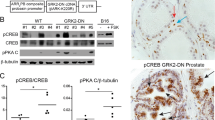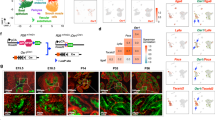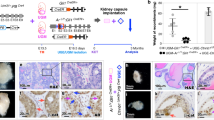Abstract
The expression of fibroblast growth factor receptor (FGFR)-1 correlates with angiogenesis and is associated with prostate cancer (CaP) progression. To more precisely define the molecular mechanisms whereby FGFR1 causes angiogenesis in the prostate we exploited a transgenic mouse model, JOCK-1, in which activation of a conditional FGFR1 allele in the prostate epithelium caused rapid angiogenesis and progressive hyperplasia. By labeling the vasculature in vivo and applying a novel method to measure the vasculature in three dimensions, we were able to observe a significant increase in vascular volume 1 week after FGFR1 activation. Although vessel volume and branching both continued to increase throughout a 6-week period of FGFR1 activation, importantly, we discovered that continued activation of FGFR1 was not required to maintain the new vasculature. Exploring the molecular mediators of the angiogenic phenotype, we observed consistent upregulation of HIF-1α, vascular endothelial growth factor (VEGF) and angiopoietin 2 (Ang-2), whereas expression of Ang-1 was lost. Further analysis revealed that loss of Ang-1 expression occurred in the basal epithelium, whereas the increase in Ang-2 expression occurred in the luminal epithelium. Reporter assays confirmed that the Ang-2 promoter was regulated by FGFR1 signaling and a small molecule inhibitor of FGFR activity, PD173074, could abrogate this response. These findings establish a method to follow spontaneous angiogenesis in a conditional autochthonous system, implicate the angiopoietins as downstream effectors of FGFR1 activation in vivo, and suggest that therapies targeting FGFR1 could be used to inhibit neovascularization during initiation and progression of CaP.
This is a preview of subscription content, access via your institution
Access options
Subscribe to this journal
Receive 50 print issues and online access
$259.00 per year
only $5.18 per issue
Buy this article
- Purchase on Springer Link
- Instant access to full article PDF
Prices may be subject to local taxes which are calculated during checkout






Similar content being viewed by others
References
American Cancer Society (2006). Cancer Facts and Figures 2006. American Cancer Society: Atlanta, GA.
Bergers G, Benjamin LE . (2003). Tumorigenesis and the angiogenic switch. Nat Rev Cancer 3: 401–410.
Bicknell R, Harris AL . (2004). Novel angiogenic signaling pathways and vascular targets. Annu Rev Pharmacol Toxicol 44: 219–238.
Bikfalvi A, Klein S, Pintucci G, Rifkin DB . (1997). Biological roles of fibroblast growth factor-2. Endocr Rev 18: 26–45.
Dery MA, Michaud MD, Richard DE . (2005). Hypoxia-inducible factor 1: regulation by hypoxic and non-hypoxic activators. Int J Biochem Cell Biol 37: 535–540.
Doll JA, Reiher FK, Crawford SE, Pins MR, Campbell SC, Bouck NP . (2001). Thrombospondin-1, vascular endothelial growth factor and fibroblast growth factor-2 are key functional regulators of angiogenesis in the prostate. Prostate 49: 293–305.
Dorkin TJ, Robinson MC, Marsh C, Neal DE, Leung HY . (1999). aFGF immunoreactivity in prostate cancer and its co-localization with bFGF and FGF8. J Pathol 189: 564–569.
Foley KP, Leonard MW, Engel JD . (1993). Quantitation of RNA using the polymerase chain reaction. Trends Genet 9: 380–385.
Folkman J . (1971). Tumor angiogenesis: therapeutic implications. N Engl J Med 285: 1182–1186.
Folkman J, Hanahan D . (1991). Switch to the angiogenic phenotype during tumorigenesis. Princess Takamatsu Symp 22: 339–347.
Folkman J, Shing Y . (1992). Angiogenesis. J Biol Chem 267: 10931–10934.
Forsythe JA, Jiang BH, Iyer NV, Agani F, Leung SW, Koos RD et al. (1996). Activation of vascular endothelial growth factor gene transcription by hypoxia-inducible factor 1. Mol Cell Biol 16: 4604–4613.
Foster BA, Kaplan PJ, Greenberg NM . (1999). Characterization of the FGF axis and identification of a novel FGFR1iiic isoform during prostate cancer progression in the TRAMP model. Prostate Cancer Prostatic Dis 2: 76–82.
Freeman KW, Welm BE, Gangula RD, Rosen JM, Ittmann M, Greenberg NM et al. (2003). Inducible prostate intraepithelial neoplasia with reversible hyperplasia in conditional FGFR1-expressing mice. Cancer Res 63: 8256–8263.
Giri D, Ropiquet F, Ittmann M . (1999). Alterations in expression of basic fibroblast growth factor (FGF) 2 and its receptor FGFR-1 in human prostate cancer. Clin Cancer Res 5: 1063–1071.
Gnanapragasam VJ, Robinson MC, Marsh C, Robson CN, Hamdy FC, Leung HY . (2003). FGF8 isoform b expression in human prostate cancer. Br J Cancer 88: 1432–1438.
Greenberg NM, DeMayo F, Finegold MJ, Medina D, Tilley WD, Aspinall JO et al. (1995). Prostate cancer in a transgenic mouse. Proc Natl Acad Sci USA 92: 3439–3443.
Greenberg NM, DeMayo FJ, Sheppard PC, Barrios R, Lebovitz R, Finegold M et al. (1994). The rat probasin gene promoter directs hormonally and developmentally regulated expression of a heterologous gene specifically to the prostate in transgenic mice. Mol Endocrinol 8: 230–239.
Hayward SW, Baskin LS, Haughney PC, Cunha AR, Foster BA, Dahiya R et al. (1996). Epithelial development in the rat ventral prostate, anterior prostate and seminal vesicle. Acta Anat (Basel) 155: 81–93.
Hobbs S, Jitrapakdee S, Wallace JC . (1998). Development of a bicistronic vector driven by the human polypeptide chain elongation factor 1alpha promoter for creation of stable mammalian cell lines that express very high levels of recombinant proteins. Biochem Biophys Res Commun 252: 368–372.
Huss WJ, Barrios RJ, Foster BA, Greenberg NM . (2003). Differential expression of specific FGF ligand and receptor isoforms during angiogenesis associated with prostate cancer progression. Prostate 54: 8–16.
Javerzat S, Auguste P, Bikfalvi A . (2002). The role of fibroblast growth factors in vascular development. Trends Mol Med 8: 483–489.
Jin C, Wang F, Wu X, Yu C, Luo Y, McKeehan WL . (2004). Directionally specific paracrine communication mediated by epithelial FGF9 to stromal FGFR3 in two-compartment premalignant prostate tumors. Cancer Res 64: 4555–4562.
Kim I, Kim JH, Ryu YS, Jung SH, Nah JJ, Koh GY . (2000). Characterization and expression of a novel alternatively spliced human angiopoietin-2. J Biol Chem 275: 18550–18556.
Kwabi-Addo B, Ozen M, Ittmann M . (2004). The role of fibroblast growth factors and their receptors in prostate cancer. Endocr Relat Cancer 11: 709–724.
Lind AJ, Wikstrom P, Granfors T, Egevad L, Stattin P, Bergh A . (2005). Angiopoietin 2 expression is related to histological grade, vascular density, metastases, and outcome in prostate cancer. Prostate 62: 394–399.
Livak KJ, Schmittgen TD . (2001). Analysis of relative gene expression data using real-time quantitative PCR and the 2(-Delta Delta C(T)) Method. Methods 25: 402–408.
Mohammadi M, Froum S, Hamby JM, Schroeder MC, Panek RL, Lu GH et al. (1998). Crystal structure of an angiogenesis inhibitor bound to the FGF receptor tyrosine kinase domain. EMBO J 17: 5896–5904.
Nakamura T, Mochizuki Y, Kanetake H, Kanda S . (2001). Signals via FGF receptor 2 regulate migration of endothelial cells. Biochem Biophys Res Commun 289: 801–806.
Tait CR, Jones PF . (2004). Angiopoietins in tumours: the angiogenic switch. J Pathol 204: 1–10.
Thomson AA . (2001). Role of androgens and fibroblast growth factors in prostatic development. Reproduction 121: 187–195.
Wang F, McKeehan K, Yu C, Ittmann M, McKeehan WL . (2004). Chronic activity of ectopic type 1 fibroblast growth factor receptor tyrosine kinase in prostate epithelium results in hyperplasia accompanied by intraepithelial neoplasia. Prostate 58: 1–12.
Wang GL, Semenza GL . (1995). Purification and characterization of hypoxia-inducible factor 1. J Biol Chem 270: 1230–1237.
Wang S, Garcia AJ, Wu M, Lawson DA, Witte ON, Wu H . (2006). Pten deletion leads to the expansion of a prostatic stem/progenitor cell subpopulation and tumor initiation. Proc Natl Acad Sci USA 103: 1480–1485.
Weidner N, Carroll PR, Flax J, Blumenfeld W, Folkman J . (1993). Tumor angiogenesis correlates with metastasis in invasive prostate carcinoma. Am J Pathol 143: 401–409.
Weidner N, Semple JP, Welch WR, Folkman J . (1991). Tumor angiogenesis and metastasis – correlation in invasive breast carcinoma. N Engl J Med 324: 1–8.
Welm BE, Freeman KW, Chen M, Contreras A, Spencer DM, Rosen JM . (2002). Inducible dimerization of FGFR1: development of a mouse model to analyze progressive transformation of the mammary gland. J Cell Biol 157: 703–714.
Winter SF, Cooper AB, Greenberg NM . (2003). Models of metastatic prostate cancer: a transgenic perspective. Prostate Cancer Prostatic Dis 6: 204–211.
Zhang J, Thomas TZ, Kasper S, Matusik RJ . (2000). A small composite probasin promoter confers high levels of prostate-specific gene expression through regulation by androgens and glucocorticoids in vitro and in vivo. Endocrinology 141: 4698–4710.
Zhang L, Yang N, Park JW, Katsaros D, Fracchioli S, Cao G et al. (2003). Tumor-derived vascular endothelial growth factor up-regulates angiopoietin-2 in host endothelium and destabilizes host vasculature, supporting angiogenesis in ovarian cancer. Cancer Res 63: 3403–3412.
Acknowledgements
We thank Matthew Dougherty for advice regarding the volumetric quantitation software, ARIAD Pharmaceuticals (http://www.ariad.com/wt/page/regulation_kits) for providing AP20187, Drs Wayne Klohs and Michael Gieseg at Pfizer for providing PD173074, Deborah Kwok and Caroline Castile for animal husbandry support, Deborah Ng and Kristine Frenk for administrative support and the members of the Greenberg and Spencer laboratories for helpful advice and discussions.
Grant support: National Institutes of Health grant CA64851 (NM Greenberg).
Author information
Authors and Affiliations
Corresponding author
Additional information
Supplementary Information accompanies the paper on the Oncogene website (http://www.nature.com/onc).
Supplementary information
Rights and permissions
About this article
Cite this article
Winter, S., Acevedo, V., Gangula, R. et al. Conditional activation of FGFR1 in the prostate epithelium induces angiogenesis with concomitant differential regulation of Ang-1 and Ang-2. Oncogene 26, 4897–4907 (2007). https://doi.org/10.1038/sj.onc.1210288
Received:
Revised:
Accepted:
Published:
Issue Date:
DOI: https://doi.org/10.1038/sj.onc.1210288
Keywords
This article is cited by
-
Hyperactivated FRS2α-mediated signaling in prostate cancer cells promotes tumor angiogenesis and predicts poor clinical outcome of patients
Oncogene (2016)
-
Ligand-associated ERBB2/3 activation confers acquired resistance to FGFR inhibition in FGFR3-dependent cancer cells
Oncogene (2015)
-
Control of tumor and microenvironment cross-talk by miR-15a and miR-16 in prostate cancer
Oncogene (2011)
-
Fibroblast growth factor signalling: from development to cancer
Nature Reviews Cancer (2010)
-
FGFR3 mutations in prostate cancer: association with low-grade tumors
Modern Pathology (2009)



